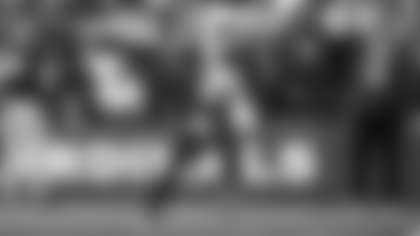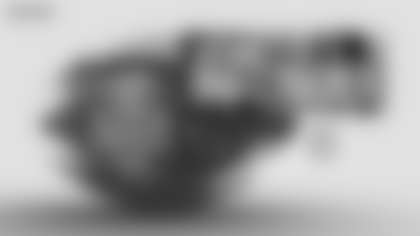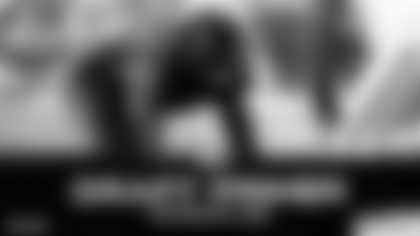Linebacker Alex Okafor gets some rehab work in this week at the Cardinals' Tempe facility.
Sunday's Super Bowl set another television ratings record, as an average 112.2 million viewers tuned in to see the Seahawks dismantle the Broncos. On Tuesday at the Cardinals training facility, the number of people watching the team's injured players rehabilitate could be counted on one hand.
The Cardinals have grand plans for 2014, with the Super Bowl held at University of Phoenix Stadium and a roster which hopes to compete for the NFC's berth in it. To get there, they will need every contribution possible, which includes the return to health of several key members who were lost to season-ending injuries. They work out now in relative anonymity, moving closer to full health each passing day with little fanfare.
"It's empty in here, so there's no distractions," said linebacker Alex Okafor, the team's 2013 fourth-round pick who was lost for the season in September with a torn bicep. "You can really get your work in and get comfortable. It gets a little repetitive, but once you do start making those steps and start new things, it's a great feeling knowing you've progressed."
Okafor is one of three rookies who ended the season on injured reserve, along with offensive guard Jonathan Cooper (broken
leg) and safety Tyrann Mathieu (torn knee ligaments). They come in most mornings for treatment, along with linebacker Sam Acho (leg), defensive tackle Alameda Ta'amu (knee) and defensive end Everrette Thompson (arm). Running back Rashard Mendenhall, tight end Jeff King, wide receiver Teddy Williams, linebacker Lorenzo Alexander and wide receiver Javone Lawson rehab away from the facility in conjunction with head athletic trainer Tom Reed.
Even though it's the dead of the offseason, the Cardinals who have remained in Tempe don't mind the slow pace.
"It's actually relaxing," Ta'amu said. "You get to come in and take your time and get better. The only thing that sucks is when you want to speed up the process – hurry up and be able to run. But as far as coming in and doing treatment, all the focus is on you rather than a whole bunch of people running around the locker room. I like that a lot."
Said Cooper: "Honestly, it's not too bad. Otherwise there would be no structure to my day and who knows what I'd be doing. With this, I get my rehab, and since I'm here I'm guaranteed to get a lift in and some running, too. It's good to stay in shape and stay around football."
Ta'amu is on crutches and still has months of rehabilitation following the torn ACL he suffered in the regular season finale against the 49ers. Mathieu is walking with a brace on his knee and also has a long journey ahead of him.
Cooper and Okafor said they are getting closer to full strength. Cooper said the plan all along has been for him to be ready for OTAs in May after going down in the preseason, and he is on schedule for that.
"It's going very well," he said. "I feel like I'm turning the corner. They're starting to cut me loose on the lower-body stuff, a little bit of agility. The straight-line stuff, that's pretty good to go for the most part. I'm in a good spot and we still have plenty of time left."
Okafor said he should be 'full-go' in about four-to-six weeks.
"My time here is almost up," he said. "I'm excited to get out there and start doing football-type things again."
The team's four trainers all have specific areas of expertise. Assistant trainer Jeff Herndon specializes in upper extremity work, while assistant Chad Cook is a lower extremity expert and return-to-play specialist. Michael Blankenship is a Doctor of Physical Therapy and is adept at immediate post-operation recovery, as well as the rehabilitation of spine injuries. Reed oversees all of the rehab and directs protocol from the team physicians.
Sometimes the rehab can get monotonous, which is where the players' competitive nature kicks in. Although they aren't on the field, there are still ways to help push each other. It's especially true for Cooper and Acho, who each broke their legs.
"We spend a lot of time together because we have the exact same injury, just about," Cooper said. "I'll see him outside running, and I'll stop to see how his running is looking. Or I'll see him do some plyometrics. It'll be, 'OK, I'm not there yet,' or, 'I'm trying to compete with him.' It really is a motivational factor."
Football players tend to naturally gravitate to teammates who play the same position, but the injured Cardinals have developed a nice camaraderie. They see each other daily and have plenty of time to talk if they are in the weight room or training room together.
"You just get into a routine like, 'Oh, what's up, guys? Back at it again,'" Cooper said. "You definitely grow a bond."
Ta'amu said he didn't even know everyone's name when he began the rehabilitation process. Now he leans on his injured teammates for support.
"It's just nice knowing you're not the only one hurt," he said.















